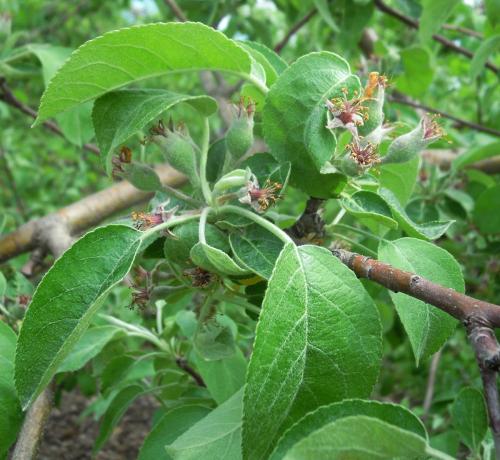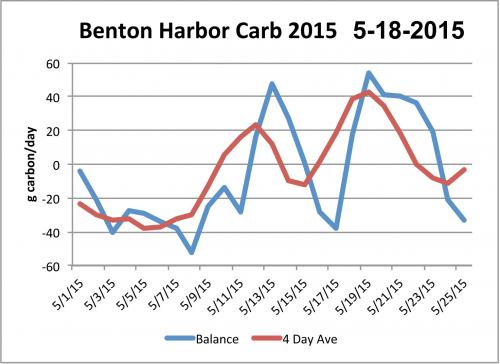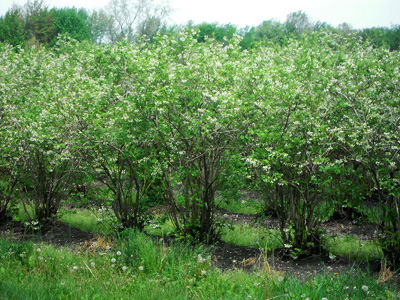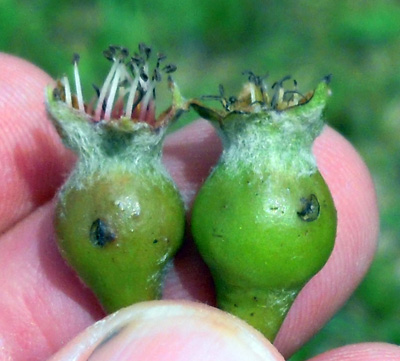Southwest Michigan fruit regional report – May 19, 2015
Very cool conditions will hold insect pests back this week. Blueberries and strawberries are blooming.

Weather
Last week was generally cool and dry with highs in the 60s and lows near 40. The weekend was warm. A warm front moved through the region Friday, May 15, bringing rain and warm, humid conditions with highs in the mid-80s for the weekend. Rainfall totals for the area ranged from 0.25-0.75 inches. Passage of a cold front Monday evening, May 18, brought cool, dry winds and no rain. Soils are moist and soil temperatures are in the 60s.
Cool, dry conditions are predicted for the upcoming week with highs in the 60s and lows in the 30s and 40s. There is a slight risk of a frost Wednesday morning, May 20, in northern areas, but it is unlikely temperatures will get cold enough (28 degrees Fahrenheit) to cause damage. Warmer conditions are forecast to return this weekend with rain forecast for Sunday, May 24. Plant development continues to be in spurts during warm periods and slow growth during cool periods. Most trees have leafed out and shoots are developing rapidly.
Southwest Michigan GDD summary from Jan. 1 to May 17, 2015 | |||
|---|---|---|---|
|
Station |
GDD 42 F |
GDD 45 F |
GDD 50 F |
|
Bainbridge/Watervliet |
583 |
462 |
299 |
|
Lawton (Lawton) |
610 |
487 |
318 |
|
Fennville (TNRC) |
487 |
379 |
237 |
|
Average for the region |
592 |
470 |
306 |
Note: The Bainbridge and Lawton Enviro-weather stations will be upgraded this week with the installation of new data loggers and sensors. They will be down temporarily, hopefully only a few hours.
Tree fruit
The spring growth flush is well underway and lots of new leaves emerged last week. The warm weekend enhanced insect activity. A few plum curculio egglaying scars were found Monday following the warm days and nights of the weekend. Plum curculio is a threat to young fruit when temperatures rise into the 70s. Tarnished plant bugs can build up on broadleaf weeds and become a threat to wing fruit.
Apricots are generally out of the shuck and the largest fruit are about 20 millimeters in diameter.
Peaches are at shuck split or out of the shuck. Growers continue to assess the health of their orchards and their economic viability following two tough winters. Some orchards have been slow to develop foliage. Peach leaf curl symptoms showed up last week. As leaf tissue becomes available, warm and wet conditions are conducive to bacterial spot, a disease of peaches and plums. Oriental fruit moth adults were caught in good numbers early this month and egg hatch is underway. Shoot strikes on peaches should appear soon. Plum curculio and tarnished plant bugs can be serious pests when warmer conditions return.
Sweet cherries are 10-14 millimeters in diameter. Plum curculio is a threat when temperatures rise above 75 degrees Fahrenheit after shuck split. Cherry leaves are always susceptible to cherry leaf spot, so apply protectant fungicides before rain events. Sweet cherries are susceptible to brown rot at all stages of development.
Tart cherries are 8-10 millimeters in diameter. The crop looks good, but we have not seen the June drop. Leaves have emerged and trees have greened up. Growers need to protect against cherry leaf spot. There was heavy cherry leaf spot infection across the region Friday, May 8. This long infection period allowed cherry leaf spot to get established early where not controlled. Growers can use the Michigan State University Enviro-weather forecast model for cherry leaf spot to help guide their sprays and track infection periods. Growers need to be sure they protect new leaves as the season progresses to slow disease progression. Tart cherries are moderately tolerant to copper applications that can help reduce bacterial canker and cherry leaf spot in cherries.
Japanese plum fruits are 6 to 10 millimeters in diameter. European plums are 5 to 7 millimeters in diameter. Plums are also susceptible to bacterial leaf spot. Growers need to protect against black knot until shoot growth ceases later in the season. Plum curculio is a threat during warm, still evenings for a few weeks following shuck split.
Apple fruits are 6-9 millimeters in diameter. Shoot growth is 2-3 inches long. Late blooming varieties such as Golden Delicious and Rome are in petal fall and still have a few open flowers on the trees. Some fruit are already beginning to drop. Apple scab symptoms reported last Wednesday, May 13. These are probably due to the April 19 infection period. More scab symptoms from the infection periods on May 5 and May 8 will appear this week.
The warm rains Friday, May 8 were also a fire blight infection across the region and rain Friday, May 15, was a fire blight infection period at some warmer sites. Fire blight symptoms will appear in a few orchards early this week, but cooler conditions will delay symptoms in most apple orchards until the warm weather returns. Michigan State University Extension suggests apple growers with concerns about fire blight use Apogee to reduce shoot growth and fire blight spread.
Insect activity increased with the warm weather. We are catching spotted tentiform leafminers in good numbers and are now at the treatment window for protecting leaves from the first generation of this pest. Codling moth adults have been trapped beginning one to two weeks ago. This week’s cooler weather should suppress codling moth activity. Plum curculio should not be a problem until we get warmer days and nights with the weekend. Cooler conditions should also suppress codling moth, but growers and scouts should have traps out to determine biofix and time their control measures.

McIntosh apple fruitlets are about 8 millimeters in diameter.
With cool weather predicted this week, it will be a poor apple thinning window. All chemical thinners work poorly under cool conditions. A better window with warmer temperatures will be the weekend when the highs rise into the 70s. The Cornell Carbohydrate Model for the Benton Harbor Enviro-weather station predicts low stress (low demand and high supply of carbohydrate) for the week. Delay thinning sprays to the weekend or beyond. A period of stress is in the forecast next week after May 24.

The Cornell Carbohydrate Model for the Southwest Michigan Horticultural Research Center, Benton Harbor, Michigan. The model estimates the carbohydrate status of apple trees as affected by current weather and tree growth stage. When the carbohydrate balance is low, the tree has a greater tendency to drop fruit. The model also shows projected carbohydrate balance status based on weather forecasts.
Pears are 10-12 millimeters in diameter. Monitoring for pear psylla now is timely to determine the need for post-bloom chemical control.
Fresh plum curculio egglaying stings on pear fruitlets, found during the warm weather Monday, May 18, 2015.
Small fruit
Grapes moved slowly during the week and then moved quickly with the warm weekend weather. Juice grapes are now in the 6- to 10-inch range and flower clusters are elongating in juice grapes. In wine grapes, shoots are in the 3- to 4-inch stage. Growers need to focus on early season disease control. At this time, the primary disease is Phomopsis. MSU Extension advises growers to apply a protectant fungicide or biological material in vineyards affected by Phomopsis before bloom to prevent disease lesions on new shoots. Phomopsis shoot lesions will slow vine growth and worsen next year’s infections.
Powdery mildew and anthracnose may also be protected against at this time, particularly in vulnerable varieties with a history of infection. There is a lot of powdery mildew inoculum in the vineyards from last fall. Powdery mildew cleistothecia produce spores above 50 degrees with any rain. Grape berry moths were out over the weekend. It is too early for treatment. Over the next few weeks, it is helpful to scout tree lines and watch the wild grape vines. Growers and scouts should record the date of 50 percent wild grape bloom. This date can be used several weeks later in the grape berry moth model to determine ideal timing of insecticide application. We are still several weeks away from bloom.
Blueberry bloom is widespread. For most varieties and areas we are past full bloom, which occurred over the weekend. Leaf emergence and shoot growth are well underway. With the widespread emergence of green leaf tissue, winter injury is becoming very apparent. This winter, there was widespread damage to flower buds and affected bushes show varying amounts of bloom. The impact of two cold winters is easy to see on older canes. Older canes that carried a crop but had few leaves last year appear dead. There are a good number of canes showing the same symptoms (heavy bloom, but few leaves and new shoots) this year. Vigorously pruned fields with younger, more vigorous canes do not show as much damage to the canes. Damage varies from region to region. In some sites, there are differences between varieties. In other sites, the differences seem to be between management practices, especially pruning.

Blueberry bloom in a well-maintained blueberry field near Paw Paw, Michigan.
Few mummy berry shoot strikes were found. Bees carry the fungus spores from the shoot strikes to open blossoms and blossoms need to be protected during bloom. See “Protect against blossom blights in blueberries” for more information. MSU Extension reminds growers to avoid pesticide sprays to blooming crops when bees are foraging in the field – even fungicide sprays. Avoid spraying during mid-day; apply sprays at night or during the early morning or evening hours when bees are not active. Galls of stem gall wasp were found on ‘Jersey’ near Covert.
Strawberries are blooming and there are thimble-sized fruit in many fields. Open flowers are killed by temperatures below 28 F. There is a slight risk of a frost in northern areas Wednesday morning, May 20, when winds calm. Remember, temperatures near the ground are much colder than reported temperatures, which are recorded 4 feet above the ground. With wet conditions, growers need to protect open blossoms and leaves. See “What fungicide do I choose for disease control in strawberries?” for more information.
Bramble shoots are 4-6 inches long and flower buds are separating in the clusters. Primocanes are showing good growth with warmer soil temperatures. Winter injury is becoming more apparent. Most blackberry canes were killed to the ground and new primocanes are emerging. Red raspberries show differing degrees of damage to the floricanes with the primary symptom being poor bud growth of buds and shoots from the floricanes. Scout black raspberries and blackberries for signs of orange rust and remove infected plants.
Upcoming meetings
There is NO Monday night meeting on May 26, Memorial Day. Our next Monday fruit IPM meeting is June 1 at Fruit Acres Farms, 3452 Friday Rd, Coloma, MI 49038 at 5 p.m. Two Michigan pesticide applicator recertification credits will be given for these meetings.
See also
- What is the difference between a frost and a freeze?
- Using Enviro-weather’s regional overnight temperature report during cold events
- Freeze damage depends on tree fruit stage of development
- Fungicide resistance management considerations for cherry leaf spot control
- Applying Apogee to apples in 2015
- The “Apogee effect” – examination of the mode of action of prohexadione calcium in shoot blight
- Scouting for blossom blight symptoms of fire blight in apples
- How to use Enviro-weather’s apple scab tool
- Stay ahead of apple scab in 2011
- SDHI fungicides for apple scab management
- Codling moths: Thinking about Enviro-weather model and hot and cold temperatures
- First generation codling moth management
- Use Precision Cropload Management tools to target apple crop load
- Protect young grape clusters from all major grape diseases
- Protect against blossom blights in blueberries
- Keep bee safety in mind during bloom



 Print
Print Email
Email



